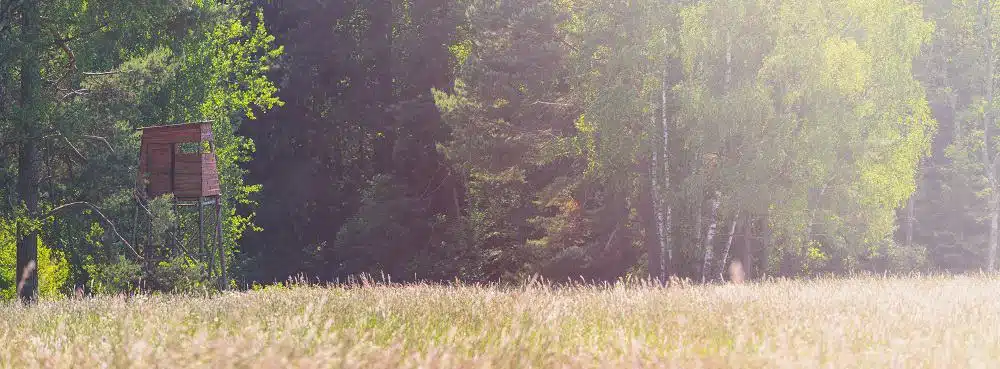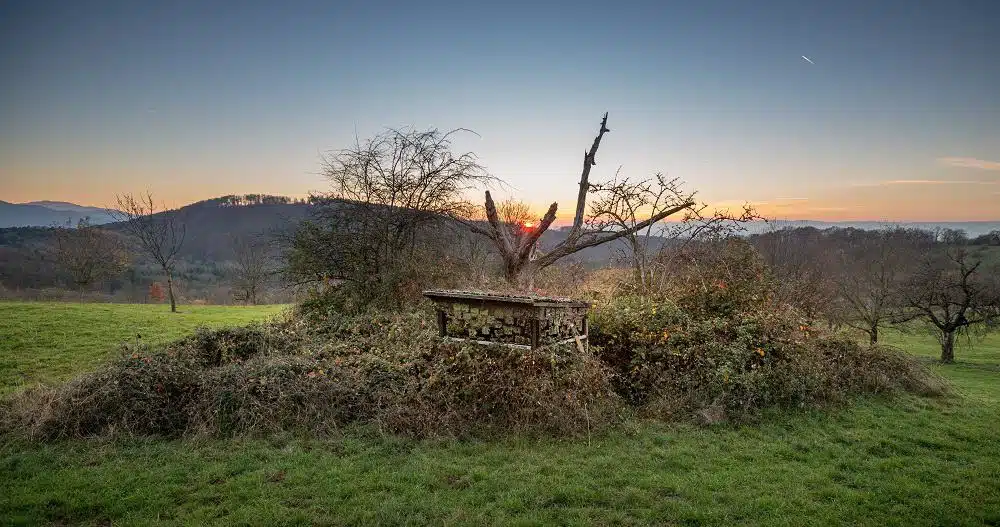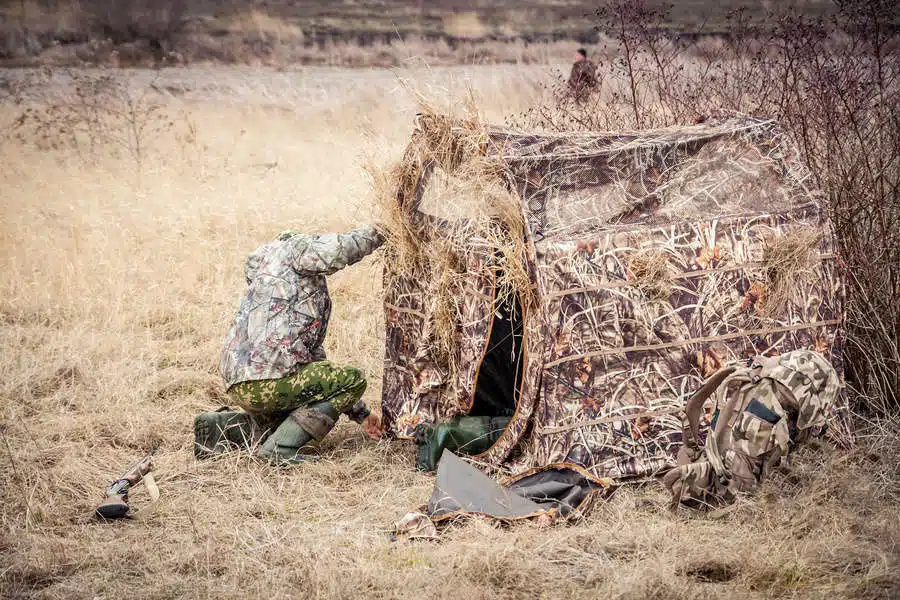Ground blind hunting is increasing its popularity year after year in the United States. The main reason for that is because it provides an additional amount of shelter for hunters that like to wait on a specific spot instead of stalking. It also conceals both your silhouette and your scent from the game in your region, making you even harder to spot. However, learning how to properly hunt from a blind can be tricky so in this article, I’ve decided to give you some of my best ground blind hunting tips and show you a few more tricks that will help you out during this season!
If you’re still looking for a good blind for this year, make sure you head over to my best ground blinds Buyer’s Guide!
How to hunt from a ground blind
As with everything else in hunting, ground blinds are invented to work in your favor. Still, if you don’t make the best out of them, you might as well be going out without one. Here are some of my best tips on how to use the blind to your advantage and catch the best buck for the season:
- Scentproofing and airing it out
- Pack the right gear
- Use the wind to your advantage
- Avoid higher vantage points
- Clear the ground
- Weatherproofing your ground blind
- Brush it in
- Don’t keep all the windows opened
- Wear black clothes
- Don’t sit too close to the windows
- Use a rubber-backed rug inside
- Remove all jewelry
- Prepare your snacks properly
- Give everything a test run before the hunting season
Let’s take a deeper look at all of those tips now…
Scentproofing and airing it out
Before the start of the season, you have to vent out the air from the inside of your blind. It doesn’t matter where you’ve kept it or whether you kept it open in your backyard. You should never first open it on your hunting spot. That will release all the scents that have been building up on the inside during the off-season. Open all of the blind’s doors and windows and let it sit like that for a few days before you take it out with you. Also, if you have a scent killer, now is the perfect time to use it.
Pack the right gear
There are quite a few things that hunters take with them along with the ground blind. Make sure that you can bring along all of the gear that will make your hunt easier and that it doesn’t weigh too much. If you’re hunting with a rifle, packing a good shooting stick is going to be essential. Shooting sticks rarely exceed a few pounds and are also good for crossbow hunters.
The next thing you need to think about is your hunting chair. There are a few things to consider with those chairs. They should be quiet, they should allow you to shoot comfortably, they should be portable, and most importantly – they should fit in your ground blind. You also need to ask yourself if you can move it around in case you need to change your position in order to make a better shot. Shooting off of it is also important.
All of that can be tested before the season starts by getting it out and taking some test shots when sitting on it. While comfort is important for a full-day sitting session, you need to be sure that it allows you to be accurate and quiet.
Click here to go to my guide on some of the best ground blind chairs for this season!
Using the wind – Learning where to place a ground blind

Let’s say that you’ve found your ideal deer hunting spot. What now? Many people tend to forget to play the wind which is one of the most important factors in deer hunting. Always hunt downwind meaning that the scent of the deer will get carried by the wind to your spot instead of the other way around. In other words, you want the wind blowing towards you and that should be the key consideration when setting up your blind.
If you’re building your own deer blind, then you should take all these things into consideration for the area as a whole. Where is the wind blowing from most of the time? Where are deer runways found most commonly in that area? Are there any feeding grounds or water sources nearby? All of these factors will help you determine the right spot to put a deer hunting blind or build one on the spot.
Avoid higher vantage points
Beginner hunters are often tempted to set up their blinds on a hill or another high vantage point. They think that gives them a clear view of a large piece of land. While that will indeed greatly improve your visibility into the region, it will also make your blind stick out like a birthday candle when looked at from the bottom of that said hill. Remember, the key here is to avoid having your blind’s silhouette visible from any angle or distance. That’s why you should avoid setting it up high on a hill unless you blend in well with the brush or trees that are there.
Clearing the ground
Before you actually set up your ground blind, spend a few minutes clearing the ground beneath it. All the sticks and leaves that you leave under your blind will crumble under your feet every time you move around in the blind. That noise will easily scare off any nearby animals, so make sure that the ground is flat and clean before you put your ground on it.
How to secure a ground blind and waterproof it
In rough rainy weather, the most important thing you should be doing is securing and waterproofing the ground blind. One of the best tactics to secure a blind is by tieing it down to nearby trees or other anchor points. For that, you will need a lot of rope, so make sure you bring some with you on the day of the ground blind setup. If you take your blind with you every time it will be useless to carry the rope with you.
Instead, you can leave it at your usual spot. If you also change spots, then you will have to rely on the weather forecast in order to know whether to take some rope with you or not.
Some modern ground blinds come with special anchors that have a screw-like form and can drill into gravel, frozen grounds, or rocky soils without an issue. Those tie-down stakes are relatively easy to carry and will make sure that your blind doesn’t move too much. Other companies rely on having spiral stakes that are virtually impossible to fly off the ground in a storm.
Some ground blinds aren’t entirely waterproof so you will need to do a few improvements so that they can handle heavy rain. The best (and cheapest) way to waterproof your blind is by using thick silicone spray. Cover the whole top part of the blind with it by paying extra attention to the seams. You can even use a seam sealer that will take care of that particular job. Do this a few days in advance so that the spray has some time to really sink in and settle into the ground blind’s material.
Brushing it in – How to camouflage a ground blind

Knowing how to properly camouflage your blind (or “brushing it in”) might prove crucial to your deer-hunting success. What you need to consider is the silhouette of your blind – the top edge, the bottom part, and all the sides. The best and most natural way to do that is by looking around your blind and gathering some local resources like sticks, brush, leaves, and other things you find around. Most modern blinds have specific slots (loops) where you can attach those elements. Always use your environment to your advantage.
Additionally, you can buy camo netting to add on top of the blind. The netting will do a great job at breaking the smooth silhouette of the blind and will make it much harder to spot out in the open. There are even synthetic branches that are being sold which can be used multiple times. When buying additional camo, make sure you match that to your surrounding colors so that you don’t create too much contrast in the colors.
- If you want something that won’t require camouflaging, check out my guide on Climbing Treestands!
Keeping your windows opened
When most beginners get a new ground blind, they usually set it up and open up all of its windows to have the best visibility possible. Well, that is one of the worst things you can do since it makes you easily visible from all sides. Try keeping the least amount of windows open. Ideally, you want to have just the front in front quarters which gives you good enough visibility of everything that passes through a 90-degree radius in front of you.
If your windows have shoot-through mesh, keep that up at all times as well. Modern shooting mesh windows make it almost impossible to see through them and are also flush with the rest of the blind’s camouflage. Keep the rear windows closed and only peek through their top-most end if you have to check what is happening behind you.
To sum all this up, always take the light that comes from behind you into consideration. Having two opposing windows opened will always create an easily distinguishable silhouette that will scare off any animal that spots it.
Wear black clothes
Even though you might’ve spent a small fortune on the latest scent-proof camo hunting clothing, you will still be visible on the inside of your blind. The reason for that is that most blinds are entirely black on the inside, making a highly-contrasting background for your camouflage clothing. Instead, just put on a black shirt and face mask. If your mask or shirt has a contrasting logo on it, just turn it inside out or around. You can even put some tape over the logo if it is small enough. If you feel like your face is also clearly visible, you can also use face paint to cover that as well.
Don’t sit too close to the windows
Even if you’re fully covered in black, sitting too close to your blind windows will allow for more light to bounce off of you. That will make you easily visible and will ruin your cover. Instead, sit at the back of your blind with just enough room behind you to comfortably fire your weapon. That will also give you enough clearance in front of you to aim your weapon, no matter if it’s a bow, a crossbow, or a rifle.
Use a rubber-backed rug
Having a rubber-backed rug on the floor of your ground blind will do you a couple of good favors. First off, it will prevent your chair from sinking into the muddy ground. It will also keep things quiet and prevent your bow or rifle from getting dirty if you put them down. It also gives you a dry area where you can change your socks or clothes.
Remove all jewelry
Being overly cautious when hunting deer is never going to work against you. This means that every little thing you can make to further noise-proof your ground blind is more than welcome. Nothing is more annoying than the clink of a ring on the riser of your bow or some other metallic noise jewelry typically makes.
Preparing your snacks
Whether you’re spending your day in a ground blind or a tree stand, you should always have some food prepared. Still, most packed foods come in a loud wrapper that makes a ton of noise when you open them. Instead, take the food out and put it in ziplocked bags or even wrap it in paper towels. Any of those two methods will contribute to your lower noise levels.
Give everything a test run before the hunting season
Regardless of how you think it will play out, certain things with your gear might always go wrong. The chair might squeak, your shooting stick might not extend properly, you might lose a few ground blind stakes, etc. This is why you should test everything out a few weeks before the season starts. Take out your blind and fully set it up with all of your gear inside. Make a few test shots, buy all the things that you are going to need, and pack things back up in your hunting day pack.
If you want to learn more about deer behavior during the rut, as well as read some of my best tips, head over to my article on some of the best deer hunting tips for beginners!
Final Words
If you’re new to hunting blinds, there might be a few things that you need to take into consideration and prepare before you head out in the open. This is why I compiled this article, summarizing all of my best ground blind hunting tips that will hopefully play a role in your deer hunting preparations. To sum things up, ventilate your ground blind, make sure that you’ve tested all of your gear, carefully pick the spots that you will hunt from, and pay attention to your noise levels and camouflage.



